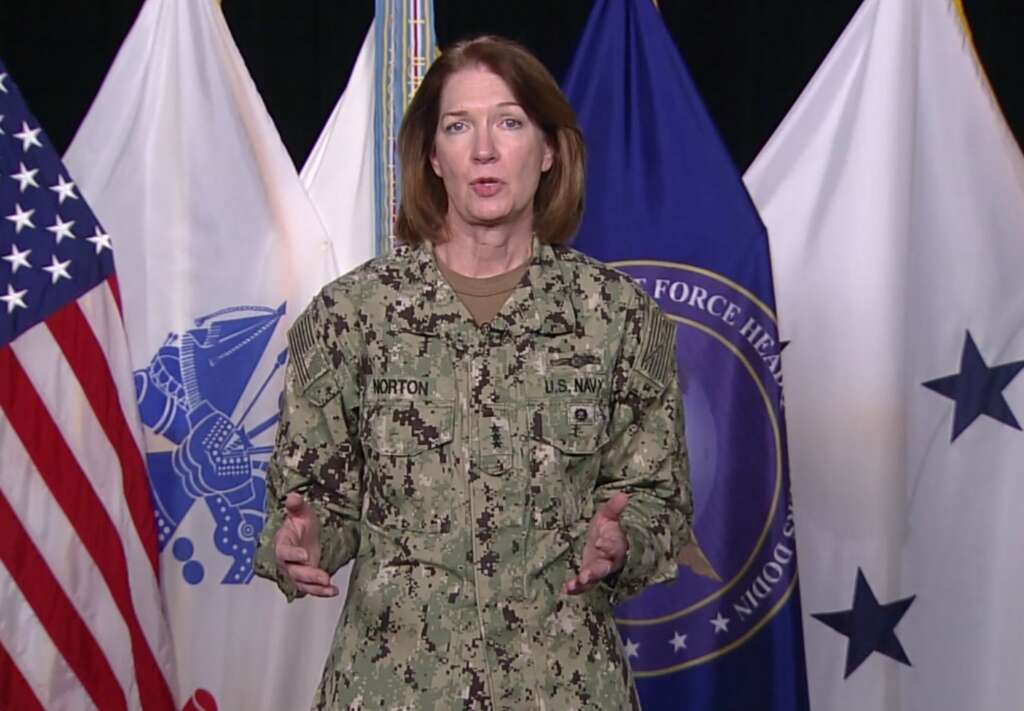
Vice Adm. Norton was ‘right leader at right time’ for DISA
Vice Adm. Nancy Norton retired after 34 years in military service, including spending the last three years as the director of the Defense Information Systems Ag...
While few thought former Rep. Mac Thornberry (R-Texas) was serious about axing the Defense Information Systems Agency in 2018, Vice Adm. Nancy Norton is credited with staving off Congressional ire.
Now three years later as Norton exited DISA after a 34-year military career, former agency executives praised her for not only “saving” the organization, but changing its trajectory to be more of a forward-thinking, cutting-edge provider of technology services.
“Vice Adm. Norton’s greatest success as director of DISA was to restore confidence in the agency. In the years prior to her assuming command, DISA had an increasingly difficult relationship with the Pentagon,” said David Mihelcic, the former chief technology officer at DISA and now the consultant. “At the same time Adm. Norton greatly improved employee morale, satisfaction and performance to ensure DISA’s ability to meet new challenges. Adm. Norton was the right leader at the right time for DISA.”
During her tenure, Norton was not known for giving speeches or making news, instead letting the senior executives at DISA claim the spotlight and credit for the agency’s successes.

Alfred Rivera, the former vice director of strategic plans at DISA and now a principal at Breakwater Solutions, echoed Mihelcic’s comments about DISA’s direction under Norton.
“Her leadership during the COVID-19 pandemic was immeasurable. Throughout the period, it was evident how focused she was on leading the organization under remote operations while simultaneously taking care of and ensuring all DISA personnel were safe and healthy under these difficult situations,” he said.
Norton’s last day as DISA director was Feb. 25. Air Force Lt. Gen. Robert Skinner replaced Norton on Feb. 26 as DISA’s new director.
Norton said on Feb. 25 during a briefing with reporters that DISA was fortunate the plan to dismantle the agency didn’t come to pass.
“Some of the most important things that we did to prevent that from getting traction and coming to fruition were telling our story and helping people understand what we actually do,” she said. “Very few people can stand back and have the full picture of the scope and scale of the mission DISA is responsible for and how significant it is. I don’t think anyone could imagine how difficult it would be to move many of those missions somewhere else.”
Reversed harmful trends
DISA’s value to DoD became more obvious during Norton’s tenure.
Rivera said Norton supported the agency’s drive to test and begin to implement new technologies like Cloud Based Internet Isolation (CBII) and Windows Data at Rest (WINDAR).
He said both of these let military servicemembers and defense agency employees more easily work remotely.
“These two solutions represent just a small example of technologies and solutions that she made available to DoD during her tenure,” Rivera said.
Mihelcic said Norton not only supported technology innovation, she reversed harmful trends.
“From significant budget cuts to pay for Joint Regional Security Stacks (JRSS), the transfer of major missions like nuclear command and control, and commercial satellite communication (SATCOM), the sidelining of DISA in the early portions of JEDI, to a Congressional proposal for outright elimination of the agency, DISA seemed to have lost the confidence of the department,” he said. “Instead of eliminating DISA, the department transfers significant new responsibilities and budget under the Defense Enclave Services (DES) program. Likewise DoD chief information officer has moved its cloud computing program office under DISA’s administrative control.”
Customers came first
Norton said DISA’s evolution over the last two years is focused on how its serves its customers.
She said her goal was to make DISA more mission focused based on customer needs.
“We have field commands and field sites with combatant commands. We have an O-6 or captain or a colonel that is part of that field office and specifically focused on the geographical or functional priorities of that combatant command to understand their priorities and mission. They can be the interface back to headquarters on what is required to support that mission,” Norton said. “We have this very robust process of mission partner engagement with each combatant command, agency or service so we can make sure we are understanding the requirements, delivering on those requirements that they actually have and accelerating the understanding so we can deliver faster and helping them to understand what the cost drivers are so we can help drive down costs.”
Norton said while the idea of having captains and colonels with the combatant commands isn’t new by any means, the importance of their roles increased over the last few years as they learn and communicate back to DISA the needs of the commanders.
One example of their impact can be directly traced to the ongoing 4th Estate back-office technology consolidation.
Norton said DISA’s offering under O365 and the Defense Enterprise Office Solutions (DEOS) contract is rolling out across the 4th Estate. She said all of DISA and initial users in each of the other agencies — 16,000 employees in all — have migrated to the new enterprise services.
“It’s working great and I’m very pleased with the capability it provides,” she said. “We will start migrating others en masse in the near future. It will be exciting to have all of us migrated here in the next couple of months.”
Under the Defense Enclave Service (DES), DISA will be the desktop service provider. Norton said it will let the field activities focus on their core missions and not have to be worried about the back-end infrastructure and services.
This is another example of DISA’s evolution over the last few years, developing a common set of standards for the desktop, for the security and for the delivery of services.
“We on-boarded the first group of people over the summer and migrated the first agency, Defense Technical Information Center (DTIC), and we will move on from there, starting with the small ones and accelerating with larger ones with DES contract,” she said.
While Norton was not a flashy DISA leader and one that probably would’ve preferred not to do the “rubber chicken” speaking circuit, her impact on the agency was clear and respected inside and out of the DoD.
Copyright © 2024 Federal News Network. All rights reserved. This website is not intended for users located within the European Economic Area.
Jason Miller is executive editor of Federal News Network and directs news coverage on the people, policy and programs of the federal government.
Follow @jmillerWFED
Related Stories

Cloud based internet isolation initiatives to give DoD new kind of cyber protections





